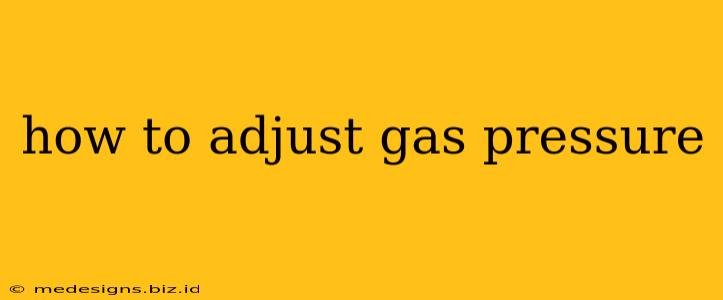Maintaining the correct gas pressure is crucial for the safe and efficient operation of gas appliances. Whether you're dealing with a gas stove, water heater, furnace, or grill, understanding how to adjust gas pressure can prevent accidents and ensure optimal performance. This comprehensive guide will walk you through the process, emphasizing safety precautions and offering troubleshooting tips.
Understanding Gas Pressure
Before diving into adjustments, it's essential to understand what gas pressure is and why it matters. Gas pressure is the force exerted by the gas within your system. Too little pressure results in weak flames, poor heating, and inefficient appliance operation. Too much pressure can lead to dangerous situations, including explosions or fires. The ideal pressure varies depending on the appliance and the type of gas (natural gas or propane). Always consult your appliance's manual for the recommended pressure range.
Types of Gas Pressure
There are two main types of gas pressure to consider:
-
Input Pressure: This is the pressure of the gas entering your home from the main gas line or propane tank. This pressure is generally regulated by your gas meter or tank regulator and usually shouldn't require adjustment by the homeowner.
-
Output Pressure: This is the pressure of the gas delivered to the appliance's burners or heating elements. This is the pressure you might need to adjust, usually through a regulator or valve specifically designed for that appliance.
Safety First: Crucial Precautions
Adjusting gas pressure is inherently risky. If you are not comfortable performing this task, contact a qualified gas technician. Incorrect adjustments can lead to serious safety hazards.
Before beginning any adjustments:
- Turn off the gas supply: This is the most crucial step. Locate the main gas shut-off valve and turn it completely off.
- Ventilate the area: Ensure proper ventilation to prevent the buildup of gas.
- Use appropriate tools: Use only the tools specified in your appliance's manual.
- Check for leaks: After making any adjustments, carefully check for gas leaks using soapy water. Bubbles indicate a leak.
- Consult the manual: Always refer to your appliance's manual for specific instructions and safety precautions.
Adjusting Gas Pressure on Different Appliances
The methods for adjusting gas pressure vary considerably depending on the appliance. Here's a general overview, but always consult your appliance's manual for precise instructions.
Gas Stoves
Most gas stoves do not have user-adjustable gas pressure. If you experience problems with your gas stove's flame, such as weak flames or uneven heating, the issue likely stems from clogged burners or a problem with the gas supply itself, and you should consult a professional.
Gas Water Heaters
Gas water heaters often have a gas pressure regulator that can be adjusted. However, this is usually a complex procedure and should only be attempted by trained professionals. Incorrect adjustments can damage the water heater or create dangerous situations.
Gas Furnaces
Similar to water heaters, gas furnace pressure adjustments should be left to qualified technicians. These furnaces have intricate pressure regulators and safety mechanisms that require specialized knowledge to adjust safely and effectively.
Gas Grills
Gas grills may have adjustable regulators on individual burners. Check your grill's manual for specific instructions on how to adjust the gas pressure for each burner. Usually, this involves turning a knob or adjusting a screw on the regulator.
Troubleshooting Low Gas Pressure
If you experience low gas pressure, the problem may not lie with the appliance itself. Here are some things to check:
- Gas Supply: Ensure the main gas supply is turned on and there are no obstructions in the gas line.
- Clogged Burners: Clean the burners on your appliance to remove any debris or clogs that may be restricting gas flow.
- Gas Regulator: Inspect the gas regulator for any damage or malfunction.
- Gas Line: Check for any kinks, bends, or damage in the gas line.
When to Call a Professional
If you're unable to resolve low gas pressure issues or are uncomfortable making adjustments yourself, contact a qualified gas technician immediately. Gas leaks can be incredibly dangerous, and it's crucial to have a professional assess and repair any issues to ensure safety.
Remember, safety is paramount when dealing with gas appliances. Always prioritize safety and seek professional help when necessary.
